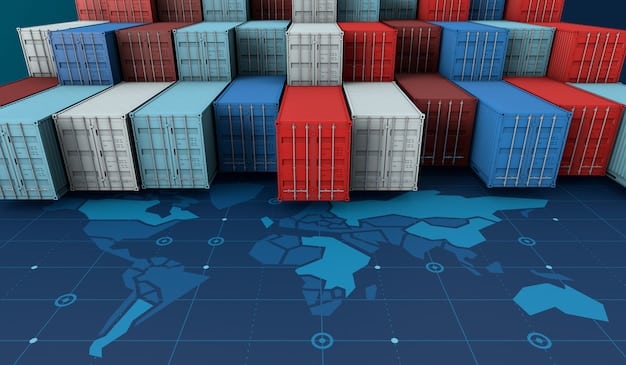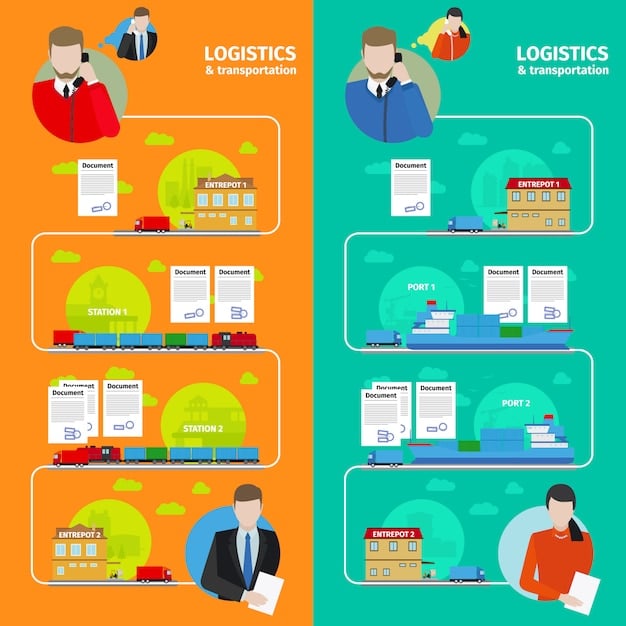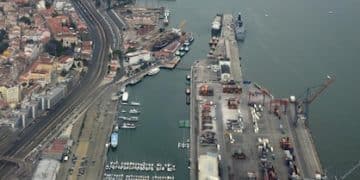Peru’s New Export Policies: A US Business Guide

Peru’s new export promotion policies aim to diversify its export markets and encourage value-added exports by offering incentives, streamlined procedures, and support for SMEs.
The Peruvian government has recently rolled out new export promotion policies designed to boost its economy and diversify its trade relationships. For Peru’s New Export Promotion Policies: What US Businesses Need to Know, this presents both opportunities and challenges that require careful understanding and strategic adaptation.
Understanding Peru’s Export Promotion Landscape
To fully grasp the implications of Peru’s new export policies, it’s essential to understand the existing landscape of export promotion in the country. This involves a look at the key players, strategies, and overall objectives that drive Peru’s export ambitions.
Key Institutions and Agencies
Several government agencies and institutions play a crucial role in shaping and implementing Peru’s export promotion policies. These include the Ministry of Foreign Trade and Tourism (MINCETUR), PromPeru, and various sector-specific organizations.
- MINCETUR (Ministerio de Comercio Exterior y Turismo): This ministry is responsible for formulating and executing Peru’s trade policies, including export promotion strategies.
- PromPeru (Comisión de Promoción del Perú para la Exportación y el Turismo): As the official export and tourism promotion agency, PromPeru provides market intelligence, trade facilitation services, and promotional support to Peruvian exporters.
- Sector-Specific Organizations: Various industry associations and chambers of commerce also contribute to export promotion efforts by providing specialized support and advocacy for their respective sectors.
Strategic Objectives and Priorities
Peru’s export promotion policies are guided by a set of strategic objectives and priorities aimed at achieving sustainable export growth and diversification. These include:
- Diversification of Export Markets: Reducing reliance on traditional markets, such as the United States and China, by exploring new opportunities in emerging economies and regions.
- Promotion of Value-Added Exports: Encouraging the export of higher-value goods and services, fostering innovation, and enhancing competitiveness in global markets.
- Support for SMEs: Providing targeted assistance and resources to small and medium-sized enterprises (SMEs) to enable them to participate in international trade.
In conclusion, understanding the key institutions, strategic objectives, and priorities driving Peru’s export promotion landscape is essential for US businesses looking to engage with the Peruvian market. This knowledge allows for informed decision-making and effective adaptation to the evolving trade environment.
Key Elements of the New Export Promotion Policies
The new export promotion policies introduced by the Peruvian government encompass a range of measures designed to streamline trade processes, offer financial incentives, and enhance the competitiveness of Peruvian exporters. These policies are structured to attract foreign investment and foster growth across various sectors.

Simplified Customs Procedures
One of the primary focuses of the new policies is the simplification of customs procedures. This includes reducing bureaucratic hurdles, implementing electronic documentation systems, and expediting the clearance of goods at ports and borders.
Financial Incentives and Support
To encourage export activity, the Peruvian government offers various financial incentives and support programs, such as tax breaks, export credit guarantees, and subsidies for research and development (R&D).
- Tax Incentives: Reduced tax rates for export-oriented businesses, exemptions from certain taxes and duties, and other fiscal benefits.
- Export Credit Guarantees: Government-backed guarantees to mitigate the risks associated with export financing, enabling exporters to access credit at favorable terms.
- R&D Subsidies: Financial support for companies investing in research and development activities aimed at creating innovative export products and services.
Enhancing Competitiveness and Innovation
The new policies also aim to enhance the competitiveness of Peruvian exporters by promoting innovation, technology adoption, and skills development. This includes:
- Support for Technological Upgrading: Programs to assist companies in adopting new technologies and upgrading their production processes.
- Skills Development Initiatives: Training programs and educational initiatives to equip workers with the skills needed to compete in global markets.
- Promotion of Innovation Hubs: Creation of innovation hubs and clusters to foster collaboration between businesses, research institutions, and government agencies.
In summary, the key elements of Peru’s new export promotion policies seek to reduce barriers to trade, provide financial assistance, and enhance the overall competitiveness of Peruvian exporters, making it more attractive for US businesses to engage in trade with Peru.
Impact on US Businesses: Opportunities and Challenges
For US businesses, Peru’s new export promotion policies present both promising opportunities and potential challenges. Understanding these factors is crucial for developing effective strategies for engaging with the Peruvian market.
Increased Market Access
The new policies, by simplifying customs procedures and reducing trade barriers, can significantly improve market access for US businesses in Peru. This makes it easier and more cost-effective to export goods and services to the country.
Potential Benefits for Specific Sectors
Several sectors stand to benefit significantly from the new export promotion policies, including:
- Technology: Increased opportunities for US technology companies to provide software, hardware, and IT services to Peruvian businesses.
- Agriculture: Enhanced market access for US agricultural products, particularly specialized crops and processed foods.
- Manufacturing: Opportunities for US manufacturers to export machinery, equipment, and industrial components to Peru.
Compliance and Regulatory Considerations
US businesses need to be aware of and comply with Peruvian regulations and standards, including customs requirements, product labeling rules, and intellectual property laws. Ensuring compliance is essential for avoiding delays, penalties, and legal issues.

In conclusion, while Peru’s new export promotion policies offer significant opportunities for US businesses, it’s essential to approach the market with a clear understanding of the regulatory landscape, cultural nuances, and competitive dynamics. Proper planning and due diligence are key to maximizing success in the Peruvian market.
Strategies for US Businesses to Leverage the New Policies
To effectively leverage Peru’s new export promotion policies, US businesses should adopt proactive strategies that align with their business objectives and market conditions. This involves conducting thorough market research, building strong relationships with local partners, and utilizing government support programs.
Market Research and Due Diligence
Conducting comprehensive market research is essential for identifying opportunities, assessing risks, and understanding the competitive landscape in Peru. This includes:
- Identifying Target Markets: Determining which sectors and regions in Peru offer the greatest potential for your products or services.
- Analyzing Competitors: Assessing the strengths and weaknesses of your competitors, their market share, and pricing strategies.
- Understanding Consumer Behavior: Learning about the preferences, purchasing habits, and cultural nuances of Peruvian consumers.
Building Strategic Partnerships
Establishing strong relationships with local partners, such as distributors, agents, and joint venture partners, can provide invaluable access to the Peruvian market and help navigate cultural and regulatory challenges. These partnerships can also facilitate market entry and expansion.
Utilizing Government Support Programs
US businesses should take advantage of government support programs and resources available to assist with exporting to Peru, such as:
- Export Assistance Centers: These centers provide counseling, training, and market intelligence to help US companies export their products and services.
- Trade Missions: Participating in trade missions to Peru can provide opportunities to meet potential partners, customers, and government officials.
- Financial Assistance Programs: Exploring export financing programs offered by the US Export-Import Bank (EXIM) and the Small Business Administration (SBA).
Adapting Products and Services
To succeed in the Peruvian market, US businesses may need to adapt their products and services to meet local preferences and requirements. This could involve:
- Customizing Products: Modifying products to suit local tastes, such as adjusting flavors, colors, or packaging.
- Providing Localized Services: Offering customer support, technical assistance, and training in Spanish.
- Pricing Strategies: Adjusting pricing to reflect local market conditions and competition.
In conclusion, successfully leveraging Peru’s new export promotion policies requires a proactive and strategic approach. By conducting thorough research, building strong partnerships, utilizing government resources, and adapting to local market conditions, US businesses can maximize their opportunities and achieve sustainable growth in Peru.
Case Studies: Successful US-Peru Trade Engagements
Examining successful case studies of US businesses that have effectively engaged in trade with Peru can provide valuable insights and practical lessons for other companies looking to enter or expand in the Peruvian market. These examples showcase strategies, best practices, and common pitfalls to avoid.
Technology Company: Software Solutions for the Mining Sector
A US-based technology company specializing in software solutions for the mining sector successfully entered the Peruvian market by partnering with a local distributor with strong relationships in the mining industry. The company adapted its software to meet the specific needs of Peruvian mining companies and provided training and technical support in Spanish. This resulted in significant sales growth and market share gains.
Agricultural Products: Exporting Specialty Crops
A US agricultural company exporting specialty crops, such as organic fruits and vegetables, successfully penetrated the Peruvian market by focusing on high-end supermarkets and organic food stores. The company invested in marketing and promotional activities to raise awareness of its products and build strong relationships with local retailers. This resulted in a loyal customer base and premium pricing.
Manufacturing: Supplying Industrial Equipment
A US manufacturer of industrial equipment successfully exported its products to Peru by participating in trade shows and partnering with a local engineering firm. The company offered customized solutions and provided after-sales service and spare parts through its local partner. This resulted in long-term contracts and repeat business.
These case studies highlight the importance of several key factors for success in the Peruvian market:
- Strategic Partnerships: Collaborating with local partners who have market knowledge, relationships, and resources.
- Adaptation and Customization: Tailoring products and services to meet local needs and preferences.
- Customer Focus: Providing excellent customer service, technical support, and after-sales service.
Future Trends and Outlook for US-Peru Trade Relations
Looking ahead, the future of US-Peru trade relations appears promising, with several trends and developments expected to shape the landscape in the coming years. These include the expansion of free trade agreements, the growth of digital trade, and increased focus on sustainability.
Expansion of Free Trade Agreements
The existing US-Peru Trade Promotion Agreement (TPA) has been instrumental in boosting trade between the two countries. Further expansions and enhancements to the agreement could create new opportunities for US businesses in sectors such as services, investment, and intellectual property.
Digital Trade and E-commerce
The growth of digital trade and e-commerce is transforming the way businesses operate and trade internationally. US companies can leverage e-commerce platforms and digital marketing tools to reach Peruvian consumers and expand their market presence. This also includes opportunities in cross-border data flows and digital services.
Sustainability and Responsible Business Practices
There is a growing emphasis on sustainability and responsible business practices in global trade. US businesses that prioritize environmental protection, social responsibility, and ethical sourcing are likely to gain a competitive advantage in the Peruvian market. This includes adopting sustainable supply chain practices, reducing carbon emissions, and supporting local communities.
Investment Opportunities in Key Sectors
Key sectors in Peru that offer attractive investment opportunities for US businesses include infrastructure, energy, mining, and agribusiness. These sectors are poised for growth and modernization, driven by government investments and private sector initiatives.
In the coming years, US-Peru trade relations are expected to deepen and diversify, driven by technological advancements, evolving consumer preferences, and a shared commitment to sustainable development. By staying informed about these trends and adapting their strategies accordingly, US businesses can unlock new opportunities and build long-term success in the Peruvian market.
| Key Point | Brief Description |
|---|---|
| 📈 Market Access | New policies simplify customs, boosting access for US businesses. |
| 💰 Financial Incentives | Tax breaks and credit guarantees encourage export activities. |
| 🤝 Strategic Partnerships | Local partners vital for navigating cultural and regulatory landscapes. |
| 🌱 Sustainability | Focus on responsible practices gains a competitive edge. |
FAQ
▼
The primary goals are to diversify export markets, promote value-added exports, and support small and medium-sized enterprises (SMEs) in international trade.
▼
The policies aim to reduce bureaucratic hurdles, implement electronic documentation, and expedite clearance of goods at ports and borders, making trade more efficient.
▼
Incentives include tax breaks, export credit guarantees, and subsidies for investing in research and development (R&D) to foster innovation.
▼
Technology, agriculture, and manufacturing sectors are expected to benefit significantly due to increased market access and support for innovation.
▼
US businesses should be aware of and comply with Peruvian regulations, including customs, labeling, and intellectual property laws to avoid penalties.
Conclusion
Peru’s new export promotion policies present a unique opportunity for US businesses to expand their reach and engagement within the Peruvian market. Understanding the nuances of these policies, building strategic partnerships, and adapting to local market conditions will be key to unlocking sustainable growth and mutual prosperity.





